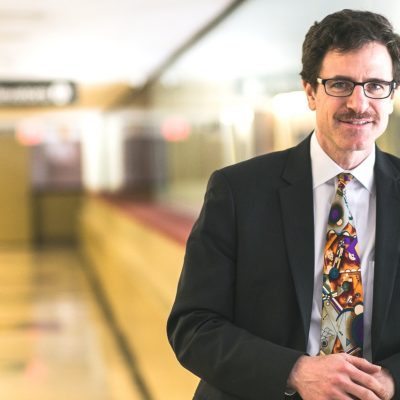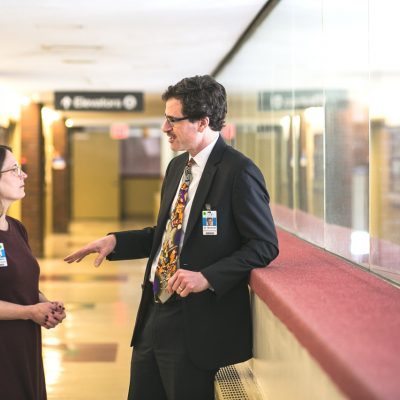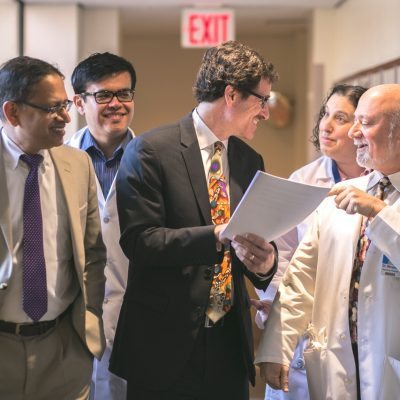VICE CHAIRMAN OF THE DEPARTMENT OF NEUROSCIENCES AT NEW YORK METHODIST HOSPITAL, ON THE COMPLEX WAYS IN WHICH NERVES COMMUNICATE WITH THE BRAIN
BY MEGAN SHADE • PHOTOS BY ALEX BARRETO
If everything had gone according to the initial plan, Cary Buckner, M.D., vice chairman of the Department of Neurosciences at New York Methodist Hospital (NYM), would be on a ski slope in Colorado right now. As the son of a doctor, he wanted to walk his own path, and going into medicine was the farthest thing from his mind. “I thought I would study engineering and parlay that somehow into skiing,” he laughed. “All it took was a college psychology class to hook me on the brain. I realized that studying the brain was like studying the engineering of the human body. Looking at medicine from that point of view, I was eager to enter the field.”
“I studied at Georgetown University’s School of Medicine, which had a particularly strong neurology program, and that early exposure really drove my desire to focus on the brain and nervous system and how they function,” said Dr. Buckner. “I continued my training with a residency and fellowship in neurology at Columbia Presbyterian Medical Center here in New York, and was fortunate enough to be mentored by some truly gifted physicians who demonstrated how neuroscience can transform peoples’ lives.”
Simply defined, neurology is the study, diagnosis, and treatment of disorders of the nervous system. Yet the field of neurology is not simple— frequently it is complex and mysterious. Neurological symptoms can present themselves in unusual and indirect ways, and diagnosis may require some sleuthing. The nerves have a complex way of communicating with the brain and with other parts of the body, so neurology can be a lot like trying to crack a code or a mystery. And as with any other mystery, the more sleuths on the project, the greater the chance of solving it.
“At NYM, every member of the neurology team, from the chairman of neurosciences, Miran Salgado, M.D., on down, has a particular specialty, so when we come together to discuss a patient, there is an incredible amount of clinical knowledge and experience in the room,” said Dr. Buckner. “We are all involved in each other’s cases.”
“For instance, my area of neurological expertise is neuromuscular disorders. If a colleague suspects that a patient may have a disease of the nerve or muscle, she calls me in to consult. Similarly, if I see a patient and suspect that epileptic seizures may be at the root of my patient’s blackouts, I will call in Shahin Nouri, M.D., or Andrew Dawson, M.D., who run our Comprehensive Epilepsy Program.”
“A team approach is essential to developing the best treatment plan for a patient,” added Dr. Salgado. “Neurological disorders appear in so many ways, from gait issues and physical tics to behavioral and psychological abnormalities. The strength of our department is the ability to draw on a number of subspecialties to diagnose and treat neurological disorders. In fact, we are able to draw on the clinical knowledge of the entire NYM faculty, even those outside the field of neurology, which is often necessary in diagnosing and treating neurological issues.”
The Department of Neurosciences at NYM is home to a number of specialty programs and centers of excellence, including the Parkinson’s Disease and Movement Disorders Program led by Dr. Salgado and Daryl Victor, M.D., the Neuropathy and Neuromuscular Program led by Dr. Buckner and Adina Alport, M.D., the Comprehensive Epilepsy Program directed by Drs. Nouri and Dawson, the Multiple Sclerosis Center headed by Kristin Babinski, M.D., a unique pediatric neurology program run by Romaine Schubert, M.D. (in cooperation with the Department of Pediatrics), the rehabilitation medicine program directed by Mona Elkomos-Botros, M.D., the inpatient and outpatient psychiatric service led by Jesse Colah, M.D., and the Memory and Attention Center run by neuropsychologist Albert Ortega, Ph.D. NYM is also home to an award-winning New York State certified Stroke Center, led by an interdepartmental team of stoke specialists.
“In my area of neuropathy and neuromuscular disorders, we work with problems associated with muscle, nerve, or neuromuscular connections, such as muscular dystrophy, myasthenia gravis, and Guillain-Barre syndrome,” said Dr. Buckner. Symptoms of a neuromuscular disorder may include weakness, poor balance, numbness, paresthesias (burning or tingling sensation), and pain in the legs, arms, and feet. “Depending on the symptoms, we may run blood and cerebrospinal fluid tests and take muscle and nerve biopsies. We may also use electromyography (EMG) if we suspect a condition such as carpal tunnel syndrome, neuropathy, or motor neuron disease.” EMG includes a nerve conduction study, which shows how signals travel along nerve fibers, and needle electromyography, in which a thin needle electrode inserted into the muscle records the muscle’s electrical activity.
Once the diagnosis of a neuromuscular disorder is confirmed, treatment may include medication, pain management, surgery, immune system modifying agents, or genetic counseling. Physical therapy, lifestyle changes, and gait and balance training may also be part of the treatment.
“There is no one-size-fits-all approach for these disorders,” Dr. Buckner explained. “Each plan is customized to address the patient’s very specific and unique needs, and is administered by an equally select team of neurological specialists. I may be your doctor, but the whole department is working towards the best outcome possible.”
New York Methodist Hospital
506 Sixth Street / 718.780.3000
nym.org







